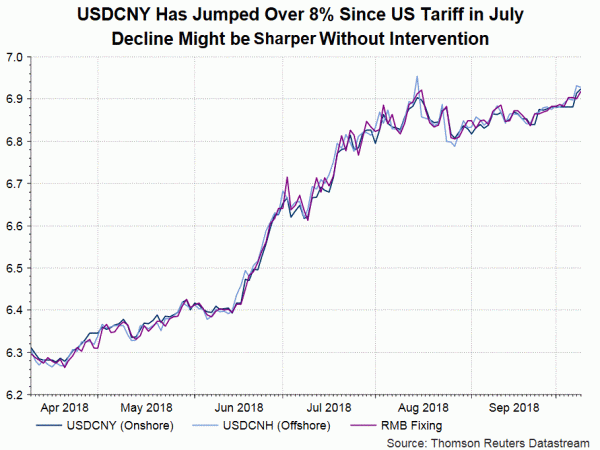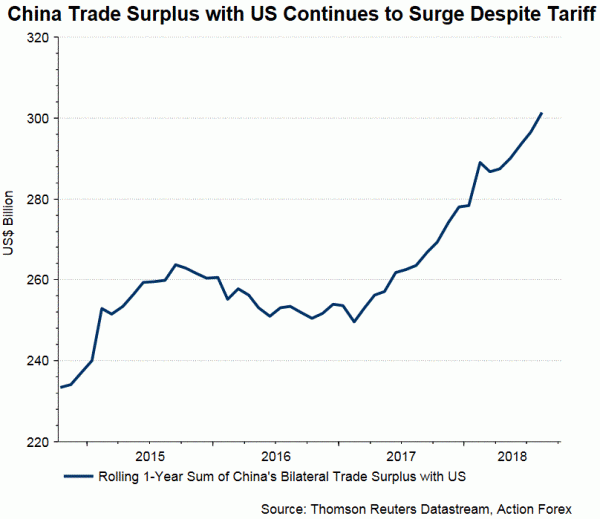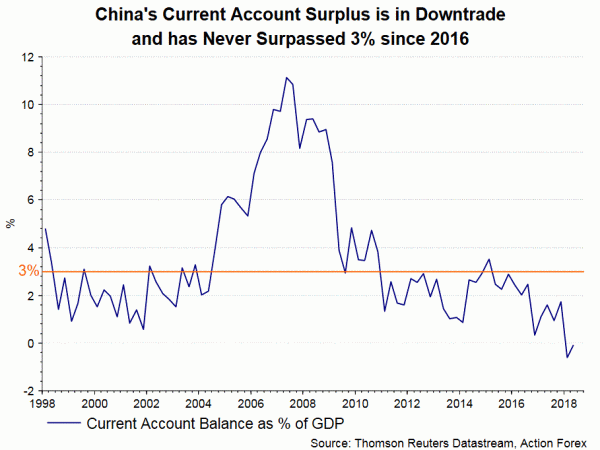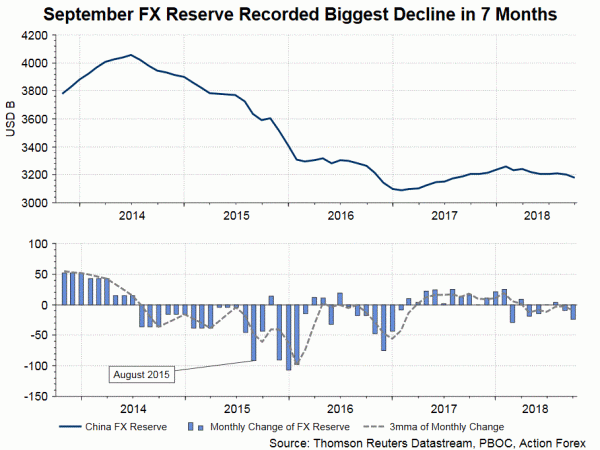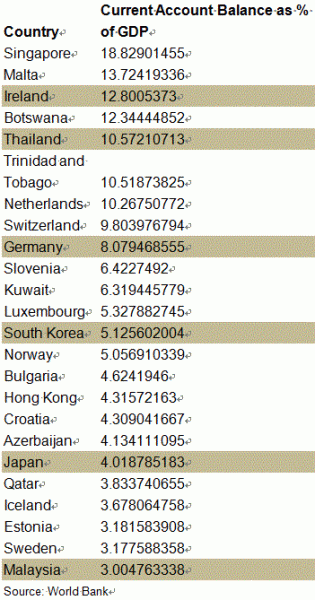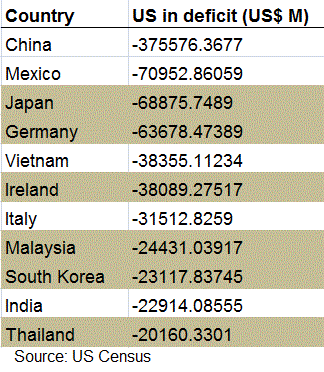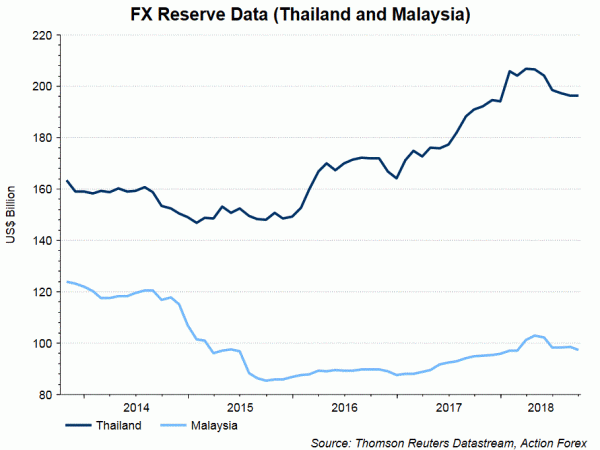As US-China trade war continues to evolve, the market is increasingly concerned over the pace of slowdown in China’s economic growth. Meanwhile, weakness in renminbi (China Yuan) has given more bullets for the White House to attack China and threaten to impose more restriction. US Treasury’s semiannual currency report, due next week, is under the spotlight as US officials have recently reiterated worries over recent renminbi deprecation. Some media have noted that US Treasury might label China as currency manipulator in the report.
Trump’s pledge to label China as currency manipulator is all foam, no beer, both during his election campaign and after he has taken office. China, along with 5 other countries (Japan, Germany, India, South Korea and Switzerland), was put on the “monitoring list” in the last semiannual currency report. Yet, it was not labeled as currency manipulator. Some US officials have proposed that the Treasury could take action this time by using the 1988 Omnibus Trade and Competitiveness Act, rather than the Trade Facilitation and Trade Enforcement Act (and specifically the Bennet Amendment; Section 701) passed in 2015. This is because the latter has listed three quantitative criteria for being currency manipulator while the former is vaguer!
The Impacts of Being Labeled as Currency Manipulator
As the 1988 Act noted, “the Secretary of the Treasury shall analyze on an annual basis the exchange rate policies of foreign countries, in consultation with the International Monetary Fund, and consider whether countries manipulate the rate of exchange between their currency and the United States dollar for purposes of preventing effective balance of payments adjustments or gaining unfair competitive advantage in international trade”. Yet, the act suggested that, in case of manipulation, the Treasury secretary shall “initiate negotiations with such foreign countries on an expedited basis, in the IMF or bilaterally, for the purpose of ensuring that such countries regularly and promptly adjust the rate of exchange between their currencies and the US dollar”. Also the secretary “shall not be required to initiate negotiations in cases where such negotiations would have a serious detrimental impact on vital national economic and security interests”. In short, no penalty is authorized under the 1988 act.
On the other hand, the 2015 Trade Act has laid down three numerical criteria. And, the Treasury has to “commence enhanced bilateral engagement” with the country which it has found violation. If the situation remains unchanged after year, the President is required to take one or more of the following actions:
- Prohibit the Overseas Private Investment Corporation from approving any new financing (including any insurance, reinsurance, or guarantee) with respect to a project located in that country on and after such date.
- Prohibit the Federal Government from procuring, or entering into any contract for the procurement of, goods or services from that country.
- Call for IMF’s additional surveillance
- Negotiate new trade agreements with the country, taking into account that country’s currency practices
http://uscode.house.gov/view.xhtml?req=(title:19%20section:4421%20edition:prelim)
While the ambiguity of the 1988 Act gives the Treasury more flexibility to label a country as currency manipulator, it has not endorsed any penalty or sanction, rather than “negotiation”. The 2015 Act is more concrete, listing both criteria of being currency manipulator and follow-up measures.
| Legislation | Criteria | Threshold |
| 1988 Omnibus Trade and Competitiveness Act | 1. signaficant bilateral trade surplus with US | |
| 2. matieral global account surplus | ||
| 2015 Trade Facilitation and Trade Enforcement Act | 1. signaficant bilateral trade surplus with US | US$ 20B |
| 2. matieral global account surplus | 3% of GDP | |
| 3. engaged in persisten one-sided intervention in FX market | 2% of GDP over 12-month period |
China’s Currency Manipulation
As mentioned in previous reports, China only satisfies one of the criteria laid down in 2015 Act with huge bilateral trade surplus with US. Obviously, the Treasury has no ground to label China as currency manipulator under the 2015 Act. However, even if China has met all the criteria, we wonder if Trump is authorized to impose more tariffs. Threatening to label China a currency manipulator indicates that Trump’s China policy remains tough, at least before mid-term elections
Such threat is premised on the assumption that currency intervention would only lead to currency depreciation. Yet, in recent years, while China has continued to grip tightly renminbi movement, its objective is to keep the movement stable. The latest FX reserve data signaled that PBOC might have sold FX assets to defend renminbi. We agree China is manipulating its currency, it is intervening a way such that it would not fall too sharply. Given the dismal prospect from China’s growth outlook, with the slowdown accelerated by the recent trade war, renminbi should have depreciated more sharply should there be no intervention.
Other Countries More susceptible to Currency Manipulation
World Bank’s data shows that, in 2017, the 25 countries in the first table was having current account surplus at 3% of GDP or above. The second table lists the countries with bilateral trade surplus with US at US$20B or above. The highlighted countries are those who met the first two criteria under the 2015 Act. Ironically, only three (Germany, South Korea and Japan) among the countries highlighted were put in the monitor list at the April semiannual report.
Current Account Balance as % of GDP (2017)
Bilateral Trade Balance between US and Other Countries
Concerning the third criterion, the Treasury has to see the country engaging in persistent one-sided intervention in FX market. for being judged as “persistent”, the country in question would have purchased FX on net for 8 of the 12 months and the the net purchase should reach 2% of GDP over 12-month period.
In the April semiannual report, the US criticized Germany’s huge trade surplus and its accumulation of foreign assets. Yet, it refrained from blaming Germany from currency intervention as ECB has not intervened unilaterally in foreign currency markets in over 15 years. Treasury showed concerns over the “pick-up in intervention in November 2017 and January 2018” but noted that “these purchases were partially reversed through foreign exchange sales in February 2017”. For sure, the US attempted to get an upper in the KORUS trade deal renegotiation by being picky on Korea. There are probably fewer reasons to blame Japan, as the yen has been relatively strong.
We wonder why there were no mention about the practices of Thailand and Malaysia in the April report. For instance, Rhailand recorded net purchase on FX for 9 out of 12 months in 2017. Also, a HSBC report estimated that, as of September 2017, the country’s net FX purchase reached 5% of GDP. If the US had not “monitored” Thailand at the April report, it would not do it in October, as the country’s FX reserve has been consistently dropping from the peak since the beginning of this year.
We despise China for many of its economic and trade policies. While participation virtually in all international organizations since economic reform in 70s, China’s compliance to the rules of games has been declining as its economic status in the world grows. It is also notorious for tweaking the rules in its favor, despite detrimental to others. It is equally a disgrace that the Trump administration accuses China of what it is not, for political gains.




